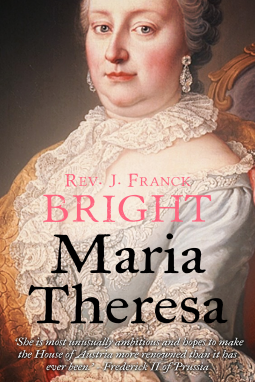
Maria Theresa
by J Franck Bright
This title was previously available on NetGalley and is now archived.
Buy on Amazon
Buy on Bookshop.org
Buy on Waterstones
*This page contains affiliate links, so we may earn a small commission when you make a purchase through links on our site at no additional cost to you.
Send NetGalley books directly to your Kindle or Kindle app
1
To read on a Kindle or Kindle app, please add kindle@netgalley.com as an approved email address to receive files in your Amazon account. Click here for step-by-step instructions.
2
Also find your Kindle email address within your Amazon account, and enter it here.
Pub Date 30 Aug 2016 | Archive Date 30 Sep 2016
Endeavour Press | Albion
Description
“To guide an empire, with even partial success, through so
dangerous a time required the hand of a statesman of more than ordinary
ability.”
One of the most intriguing women in European history, Maria Theresa of House Habsburg did not leave Europe how she found it.
After several diplomatic failures and military defeats in her father’s reign, Austria was declining and on the verge of collapse.
Despite Holy Roman Emperor Charles VI’s tireless efforts to secure his daughter’s succession over his nieces’, he did not prepare Maria Theresa for the role of sovereign.
The new Archduchess of Austria had to make her own path.
The very nature of Maria Theresa’s succession spun Europe into the bloody Wars of Austrian Succession.
Unable to become the Holy Roman Empress due to her gender, Maria Theresa set about placing her husband on the throne. To ensure his eligibility she made him co-ruler of her Austrian and Bohemian Lands.
Yet Maria Theresa never allowed him to interfere in affairs of state and would dismiss him from council meetings if he disagreed.
She gave the Habsburg dominions an efficient administrative system that allowed it to remain a great power.
Her daughters were queens of France, Naples and Sicily and one was the Duchess of Parma.
When Maria Theresa died, she had left Austria a revitalized empire that influenced the rest of Europe throughout the 19th Century.
In this account of Maria Theresa’s life and reign, the Reverend Bright explores the various aspects of her life with remarkable detail and with incredible resources.
Reverend James Franck Bright (1832-1920) studied at Rugby and University College, Oxford. He held important roles at a variety of colleges including Master of University College, Oxford. He died in Oxford.
After several diplomatic failures and military defeats in her father’s reign, Austria was declining and on the verge of collapse.
Despite Holy Roman Emperor Charles VI’s tireless efforts to secure his daughter’s succession over his nieces’, he did not prepare Maria Theresa for the role of sovereign.
The new Archduchess of Austria had to make her own path.
The very nature of Maria Theresa’s succession spun Europe into the bloody Wars of Austrian Succession.
Unable to become the Holy Roman Empress due to her gender, Maria Theresa set about placing her husband on the throne. To ensure his eligibility she made him co-ruler of her Austrian and Bohemian Lands.
Yet Maria Theresa never allowed him to interfere in affairs of state and would dismiss him from council meetings if he disagreed.
She gave the Habsburg dominions an efficient administrative system that allowed it to remain a great power.
Her daughters were queens of France, Naples and Sicily and one was the Duchess of Parma.
When Maria Theresa died, she had left Austria a revitalized empire that influenced the rest of Europe throughout the 19th Century.
In this account of Maria Theresa’s life and reign, the Reverend Bright explores the various aspects of her life with remarkable detail and with incredible resources.
Reverend James Franck Bright (1832-1920) studied at Rugby and University College, Oxford. He held important roles at a variety of colleges including Master of University College, Oxford. He died in Oxford.
Available Editions
| EDITION | Ebook |
| ISBN | 9781297907067 |
| PRICE | US$0.00 (USD) |




